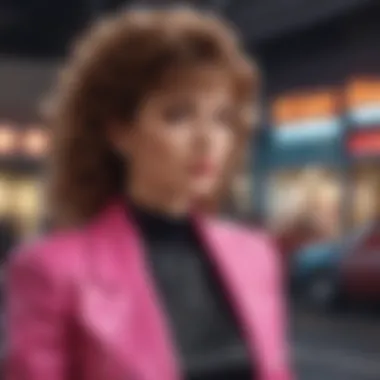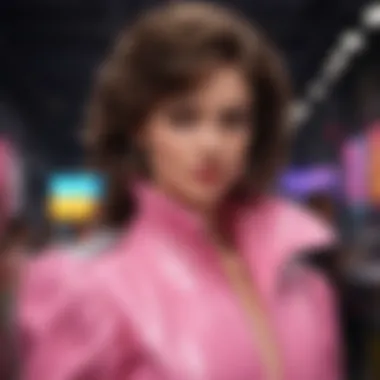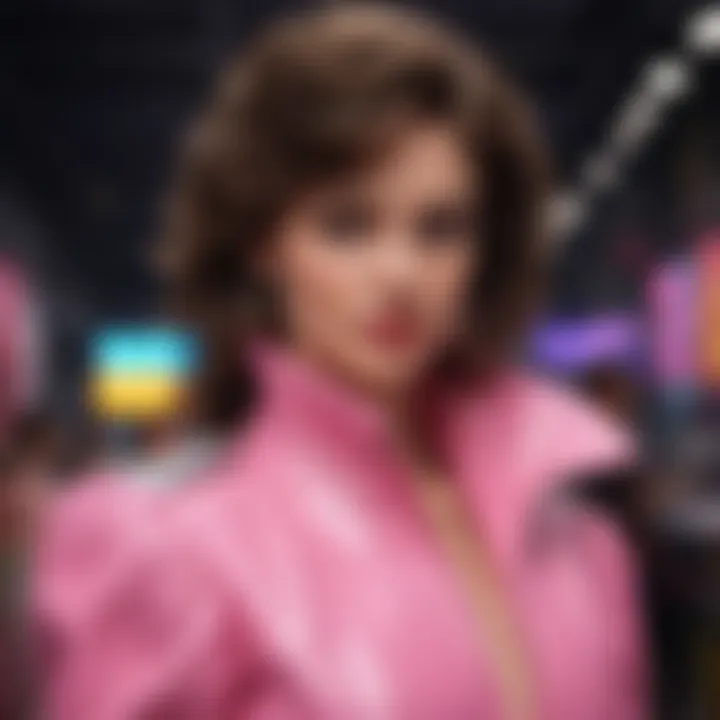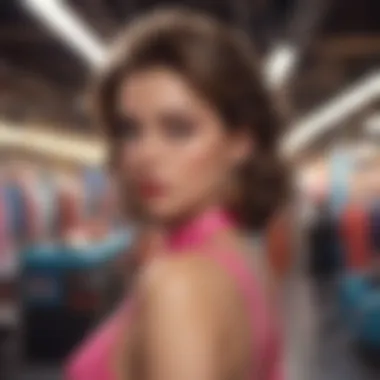Back to the 80s: Exploring Iconic Fashion Trends


Intro
The 1980s was not just a decade; it was a cultural phenomenon that transcended music and politics, spilling into every corner of life, particularly fashion. The era was marked by bold choices, defiance against norms, and a sense of liberation in personal expression. Unlike previous decades, the 80s embraced excess: volume in hairstyles, colors that screamed for attention, and silhouettes that were unapologetically dramatic. This exploration navigates through the vibrant tapestry of 80s fashion, shedding light on its standout trends, iconic pieces, and lasting relevance in today’s style landscape.
While some may view 80s fashion as merely a colorful blip in history, enthusiasts and scholars alike recognize its profound impact on contemporary wardrobes. Garish prints, oversized jackets, and a kaleidoscope of fabrics continue to inspire modern designers, solidifying the decade's status as a key period in fashion evolution. Not to mention, nostalgia plays a significant role in reviving these styles, as many individuals find themselves drawn back to the vibrancy of their childhood or teenage years.
As we peel back the layers of this decade, we will cover various aspects, including:
- The leading fashion trends that defined the era
- Influential figures and styles that shaped popular culture
- Modern influences that revive 80s aesthetics
With this backdrop, let's dive into the world of fashion trends.
Prologue to 80s Fashion
The 1980s were more than just a decade on the calendar; they represented a pivotal period in the world of fashion. This era was characterized by bold choices, significant movements, and a rich tapestry of influences that shaped personal styles and societal norms. In this exploration, the importance of 80s fashion becomes abundantly clear. Delving into this topic allows us to unearth not only the trends that defined a generation but also the cultural and social context in which they thrived.
Understanding 80s fashion helps us appreciate how everyday clothing became a powerful medium for self-expression. It also sheds light on the cyclical nature of style — many trends appear to have hibernated and now resurface in modern wardrobes. The unique blend of glamour, rebellion, and everyday wear from the 80s continues to resonate today.
Defining the Era: Key Characteristics
The defining characteristics of 1980s fashion are as diverse as the individuals who wore them. In essence, this was a decade marked by:
- Vibrant Colors: Bright hues and bold patterns dominated the clothing racks, reflecting the exuberant spirit of the time. Neon colors became synonymous with the era, making a striking impact on everything from clothing to accessories.
- Dramatic Silhouettes: Power-dressing took center stage, with oversized blazers, shoulder pads, and high-waisted trousers coming into vogue. This style was not merely about clothing; it represented an attitude of confidence, especially for women entering the workforce in unprecedented numbers.
- Eclectic Styles: The 80s embraced a mix of influences, melding punk with glam rock, hip-hop with preppy looks. This mixture encouraged individuals to curate personal styles — and to push the envelope.
These elements created a tapestry of fashion that was at once familiar and yet refreshingly new, giving people the freedom to express their identities.
The Cultural Context Influencing Style
A closer look at the cultural context of the 1980s reveals the driving forces behind the years' fashion decisions. Several factors converged to shape trends during this vibrant period:
- Music: Genres like new wave, punk, and rap influenced not only sound but style as well. Artists like Madonna and Prince were as notable for their fashion choices as their music, creating iconic looks that fans sought to emulate.
- Television and Film: Hit shows and movies created lasting impressions on fashion. Think of 'Miami Vice' — the pastel colors and tailored suits inspired viewers to imitate the leads’ striking combinations. Films such as 'The Breakfast Club' showcased the distinct styles of various teen subcultures, thereby establishing recognizable tropes.
- Social Movements: The feminist movement and LGBTQ rights advancements played key roles in redefining gender norms in clothing. Women began to embrace power suits, while the gay community championed flamboyance and expressiveness in personal style.
These factors created a rich cultural backdrop, ensuring that 80s fashion was not just about clothing but also about identity, political statements, and social evolution.
The Fabric of the 80s
The fabric choices in the 1980s were anything but ordinary. This decade revolutionized the way materials were perceived in fashion, introducing a variety of textiles that not only defined styles but also influenced the entire culture. The importance of these fabric developments can't be understated. Each material told a different story, resonating with the emotions and attitudes of the era, while paving the way for future trends.
Materials That Shaped the Decade
In the 80s, several key materials played a vital role in the fashion landscape. The industry saw a rise in the use of synthetic fabrics, which allowed for bolder designs and vibrant colors. Nylon, polyester, and spandex became household names, enabling a new level of stretch and durability in clothing. Think about the way a well-fitted bodysuit hugged the body, or how windbreakers were not only practical but also stylish.
- Nylon: Lightweight and water-resistant, this fabric became a staple for active and casual wear. The rise of aerobics and outdoor activities necessitated functional clothing that was also trendy.
- Polyester: Known for its vibrant hues and resistance to wrinkles, polyester dominated the scene. It allowed for dramatic prints and patterns that captured the essence of the decade's creativity.
- Spandex: This miracle material introduced bodies to comfort like never before. Stretchy, form-fitting apparel enabled freedom of movement, serving both the fashion and fitness conscious. High-waisted leggings and bodycon dresses can trace their roots back to this period, illustrating how spandex shaped the way we perceive casual and athletic styles today.
Textures: From Denim to Sequins
Textural variety marked the 80s, bringing freshness to the textile narrative. Denim, a classic material, was reimagined. It wasn't just about jeans anymore; you saw it in jackets, skirts, and even accessories. Acid-washed denim became a hallmark look, the kind that screamed rebellion, often paired with oversized tees or scrunched-up tops.
On the other end of the spectrum, you had sequins. Sparking like stars in the night, sequined fabrics were all about glamour and excess. They dazzled on stage at concerts and lit up dance floors—think of artists like Madonna or Prince, whose wardrobes often shimmered under the spotlight. Furthermore, sequins became associated with nightlife and parties, symbolizing what it meant to have fun in a world glamorized by pop culture.
Iconic Clothing Pieces
The 1980s marked a significant shift in fashion, characterized by pieces that not only defined personal style but also made bold statements about identity and status. The importance of iconic clothing pieces during this decade lies in their role as symbols of cultural movements and their lasting influence on contemporary fashion.
Power Suits and Professionalism
In the world of business, the power suit emerged as a defining garment of the 80s. Tailored with precision, these suits were often crafted from luxurious fabrics, featuring sharp lines and bold colors. Women, in particular, embraced the power suit to challenge traditional gender norms, representing confidence and authority in a male-dominated workplace.
- Key Features:
- Double-breasted jackets that exuded power.
- Shoulder pads that accentuated a strong silhouette.
- Tailored skirts and trousers that balanced style with professionalism.
This shift in female professional attire is often traced back to influential figures like designer Donna Karan, who revolutionized women’s workwear. As a result, the power suit not only transformed office attire but also sparked discussions around feminism and workplace equality.


Casual Wear: The Rise of Street Style
The 80s also saw the emergence of street style as a powerful fashion force. Individuals began to express their personalities through casual wear, breaking away from the more formal styles of previous decades. This evolution was a result of various cultural influences, including music, art, and social changes.
Casual clothing featured:
- Graphic tees that featured catchy slogans or iconic bands.
- Baggy jeans that emphasized comfort and individuality.
- Sneakers that became acceptable in various settings, from everyday outings to runways.
Street wear was not merely a trend; it became a means of creative expression for many. Young people used fashion to send messages of rebellion, freedom, and authenticity – a far cry from the polished aesthetic of earlier years.
Athletic and Activewear Trends
As fitness culture gained momentum in the 1980s, athletic wear transitioned from the gym to casual and street fashion. Influential figures like Jane Fonda created workout videos that inspired a surge in interest surrounding fitness, directly affecting apparel choices.
Athletic wear during this time consisted of:
- Leg warmers worn over tights, symbolizing a fun and active lifestyle.
- Spandex and lycra materials that catered to the need for comfort, flexibility, and vibrant colors.
- Tracksuits that were both practical for workouts and stylish for casual outings.
This genre of clothing blurred the lines between sporty and fashionable, emphasizing comfort without sacrificing style. Brands, such as Nike and Adidas, capitalized on this trend, creating pieces that combined functionality with aesthetic appeal.
"Fashion is a language that creates itself in clothes to interpret reality.” – Karl Lagerfeld
Culmination
The iconic clothing pieces of the 80s encapsulate an era filled with experimentation and self-expression. From power suits that redefined professionalism to casual wear that embraced street culture, the decade nurtured a diverse array of styles. Athletic wear further emphasized a health-conscious lifestyle, leading to an evolution that continues to shape today’s fashion norms.
Influential Figures in 80s Fashion
The 1980s was a decade marked by bold styles and audacious choices, and at the heart of this vibrant fashion landscape were the influential figures who shaped the era. Whether they were talented designers crafting innovative pieces or celebrities sporting the latest trends, these individuals played a crucial role in defining what it meant to be fashionable during this time. Understanding their impact helps one appreciate not just the clothing itself, but the cultural shifts that accompanied these trends.
Designers Who Left a Mark
Throughout the 80s, several designers emerged, each with their unique flair and style contributing to the fashion tapestry. Among them, Jean-Paul Gaultier is often celebrated for his avant-garde style and playful nature with androgyny. His designs brought about a new wave of creativity by blending street culture with high fashion. The use of unconventional materials and bold patterns made his pieces stand out, leading to a significant following.
Similarly, Gianni Versace dominated the scene with his luxurious yet daring styles. Known for his eye-catching prints and provocative designs, Versace's work didn't just dress the body; it crafted a persona. Silhouettes often included dramatic cuts and embellishments, making his fashion synonymous with opulence and extravagance.
In addition, Yves Saint Laurent revolutionized women’s fashion through the introduction of power suits, which further blurred the lines of traditional gender clothing. His designs exuded confidence, empowering women in a male-dominated workplace and capturing the essence of the feminist movement during the decade.
The impact of these designers resonates today, as elements of their groundbreaking work continue to be revived in contemporary fashion, proving their relevance has not faded.
Celebrities as Fashion Icons
Celebrities in the 80s weren't merely entertainers; they were trendsetters with a powerful influence over what people wore. The likes of Madonna and Prince turned the music scene into a style guide. Madonna, with her eclectic mix of lace, layered skirts, and crucifix jewelry, became a fashion symbol for a generation, representing self-expression and boldness. Her style was a loud proclamation that it was okay to stand out and be unapologetic about one's choices.
"Fashion is about dressing according to what’s fashionable. Style is more about being yourself." – Oscar de la Renta
Meanwhile, Michael Jackson showcased an unmistakable flair that transformed pop culture as much as it did fashion. His military jackets and sequined gloves became iconic, denoting glamor and sophistication interwoven with a touch of daring pizzazz. Celebrity endorsements in that period meant everything; a simple outfit worn by a star could see fashion retailers flying off shelves in no time.
Cindy Crawford, Christy Turlington, and other supermodels of the era also left an indelible mark. Their appearances in magazines and runways set trends that gravitated toward a specific kind of beauty that mixed accessibility with aspiration. As they graced the covers of Vogue or strutted down runways, they flourished a certain lifestyle that shaped public perceptions of beauty and fashion.
Subcultures and Their Styles
Understanding the subcultures of the 1980s is critical to grasping the fuller picture of the decade's fashion landscape. Each subculture not only reflects distinct aesthetics but also serves as a form of expression, often seamlessly blending music, art, and lifestyle into their apparel. These styles deeply resonated with teenagers and young adults, creating a vibrant tapestry of identity and belonging during a time of social upheaval and change.
Glam Rock and Its Flaunt
Glam Rock emerged in the early 1970s but truly flourished in the 80s, making its mark with flamboyant styles and theatrical performances. Think of figures like David Bowie and Marc Bolan, who didn't just break the mold—they shattered it. The hallmark of Glam Rock fashion includes sparkly clothing, platform boots, and bold makeup. The emphasis was on excess; glitter, feathers, and sequins ruled the stage and happened to make their way onto the streets, too.
A significant element of Glam Rock was the celebration of androgyny, allowing individuals to express their gender fluidity openly. Many adopted styles that blurred traditional gender lines.
Important elements include:
- Metallic fabrics: Shiny, reflective materials became synonymous with the genre.
- Eye-catching accessories: Spiked jewelry and oversized sunglasses were common.
- ** Iconographic hairstyles**: Big hair and outrageous hairstyles, often accentuated with color.


The movement not only defined a fashion style but also fostered an acceptance of diverse sexual orientations and gender identities in mainstream culture, making Glam Rock a pivotal influence on the fashion ethos of the era.
Punk's Rebellion Against Norms
Punk fashion is a classic example of rebellion against the status quo that defined the late 70s into the 80s. Mobility and self-expression underpinned this movement, as seen in the doodles that adorned leather jackets and jeans that many would style with safety pins and spikes.
Punk was less about looking polished and more about making a statement. This aesthetic communicated frustration with societal conventions and a desire to challenge the norms of fashion and life.
Key characteristics of Punk fashion included:
- Distressed and torn clothing: Emphasizing an anti-establishment ethos.
- Iconic footwear: Combat boots were common, symbolizing a working-class sensibility.
- DIY ethos: Many designers and enthusiasts embraced a do-it-yourself mentality, further pushing the limits of fashion.
Punk fashion constantly reinvented itself, making it a dynamic reflection of the turbulent times. Whether seen through the lens of the Sex Pistols or the style choices of individuals on the streets, it encapsulated a spirit of defiance.
Hip-Hop Fashion and Identity
Hip-hop culture, which began to take shape in the late 1970s, exploded in the 1980s, merging music, dance, and fashion into a powerful movement. The pioneers of hip-hop influenced not just musical trends but also the way people dressed and perceived themselves.
A few standouts in hip-hop fashion include oversized clothing, bold graphic tees, and flashy accessories. Popular artists like Run-D.M.C. donned gold chains and sports jerseys, portraying both swagger and street credibility.
Key elements of Hip-Hop fashion include:
- Baggy pants and oversized shirts: Comfort and self-expression combined, leaving behind tailored fits of earlier decades.
- Baseball caps and sneakers: These became staples, with brands like Adidas making significant inroads into mainstream culture.
- Brand loyalty: Logos and brand names were emblematic of social status and identity, serving as cultural markers within the community.
Hip-hop fashion conveyed a strong sense of identity and belonging within urban youth. It broke boundaries, intertwining musical influences with fashion, ultimately laying the groundwork for today's diverse style landscape.
"Fashion is not just clothing; it's a reflection of the social and cultural climate—a mirror to the pulse of a generation."
Through exploring these eclectic subcultures, one can appreciate how the 1980s were not just about clothes, but about expressing a multifaceted identity in a rapidly evolving world.
The Impact of Media on 80s Fashion
The 1980s marked a significant shift in how fashion was consumed and understood, largely due to the burgeoning influence of various media platforms. From television shows to music videos, the media not only showcased style but also provided a narrative around it, shaping public perception and driving trends in a way that had never been seen before. The interplay between fashion and these media sources created a feedback loop, where styles gained popularity and subsequently influenced the media representations themselves, making this relationship pivotal in understanding 80s fashion.
Television Shows and Their Fashion Narratives
Television in the 80s wasn’t just a source of entertainment; it became a cultural touchstone that delivered style directly into living rooms. Shows like Dynasty and Miami Vice became prime examples of how character wardrobes could dictate real-world trends.
- Dynasty introduced the idea of the power suit as worn by characters like Alexis Carrington, mixing bold colors and luxurious fabrics that soon permeated corporate America.
- On the other hand, Miami Vice created a vibe that embraced a more casual yet stylish look, merging pastel colors and high-energy street fashion with a glamorous flair.
"Fashion on television became a point of aspiration for audiences; it was not just about clothing but a lifestyle, a choice that reflected personal values and social status."
Through captivating storytelling, producers and costume designers used clothing to enrich character development and plot lines, making the fashion feel more than incidental. This created a culture where viewers were inspired to mimic the on-screen styles, leading to a surge in shopping for similar items.
Film: Portrayals of the Decade
Similarly, films of the 1980s acted as monumental catalysts for fashion trends. Iconic movies such as Flashdance, The Breakfast Club, and Working Girl didn’t simply entertain; they set trends that would echo through the years. “What could be more memorable than Jennifer Beals in that cut-up sweatshirt and leg warmers, energizing a new workout culture?”
- Flashdance popularized the idea of athleisure combined with high fashion elements, making it acceptable to wear sporty attire not just for workouts but as part of everyday fashion.
- The Breakfast Club showcased a mix of teenage subcultures, pushing styles such as the all-American casual look juxtaposed against the glam of the rich kids’ clothes.
These portrayals informed societal norms around dressing for occasions— from prom to board meetings— aligning character choices vividly with cultural acceptance and expectations.
Music Videos and Visual Influence
Music videos in the 80s brought a new layer to fashion influence. Artists like Madonna, Michael Jackson, and Duran Duran took control of their image and turned it into an aesthetic phenomenon. Their unique styles became firmly entrenched in popular culture, so much so that consumers emulated them.
- Madonna’s layered lace, rubber bracelets, and teased hair became symbols of rebellion and empowerment. Her presence in music videos blurred the lines between fashion and performance art.
- Michael Jackson’s iconic glove and military-style jacket from the Thriller video sparked a trend towards theatricality in dress that fans were eager to adopt.
The visual extravagance of these videos made fashion not just a background element but a central theme, giving viewers something to aspire to while simultaneously feeding the growing consumerist culture. Each beat and scene displayed not just music— it showcased a lifestyle that fans across the globe sought to own.
Technological Advances and Fashion
Technological advancements played a pivotal role in reshaping the fashion industry during the 1980s. The rapid developments in materials, production techniques, and manufacturing processes not only influenced what people wore but also how clothing was made, setting the stage for a more commercialized and fast-paced fashion environment. From the introduction of new synthetic fibers to improved sewing machinery, these innovations were central to defining the era's characteristic styles and trends.


How Innovations Affected Clothing Production
The '80s witnessed significant changes in clothing production methods. One notable advancement was the introduction of computer-aided design (CAD). This development allowed designers to create intricate patterns and styles more efficiently, which meant they could churn out new collections at a faster rate. Brands could keep up with ever-changing trends, meeting consumers' desires for fresh and varied wardrobes. Moreover, mass production techniques became more prevalent. With assembly lines operating like a well-oiled machine, clothing manufacturing saw a surge in efficiency.
- Cost-Effectiveness: Lower production costs made fashion more accessible. Consumers could find stylish attire without breaking the bank.
- Customization: While mass produced, some brands catered to niche markets by offering personalized options, allowing unique styles that resonated with individual tastes and cultural identities.
Given these innovations, the question arose whether fashion would lose its unique touch, becoming mere commodification. Yet, the blend of technology and artistry during this decade resulted in a vibrant tapestry of styles that reflected the complexity of modern life.
The Role of Synthetic Fabrics
Synthetic fabrics began to dominate the fashion landscape in the 80s, transforming how clothes looked and felt. Materials such as polyester, nylon, and spandex were not just affordable; they introduced a host of new benefits.
- Durability: These fabrics were not only longer-lasting but also resistant to wrinkling and shrinking, making them ideal for the active lifestyles that were becoming more popular.
- Flexibility: The stretch offered by materials like spandex led to a surge in form-fitting styles, particularly in athletic and casual wear.
- Variety of Textures: Synthetic advantages allowed designers to experiment with textures like faux fur and metallic finishes, which provided a striking contrast to the natural materials that were prevalent before.
The convenience and appeal of synthetic fabrics cannot be overstated. Though some purists deemed them less authentic, they allowed for innovation in designs that might not have been possible with traditional fabrics.
Innovations in fabric technology reshaped the very fabric of society, providing tools for self-expression and creativity that were previously unattainable.
The blend of innovation and fashion in the '80s not only changed the garments themselves but also how people interacted with and perceived fashion. As society raced into a new era, the technological influences laid the groundwork for the fashion cycles that continue to evolve today.
Nostalgia and Fashion Cycles
Nostalgia is a powerful feeling, one that can transport us back in time, stirring cherished memories and familiar emotions. In the realm of fashion, nostalgia plays a crucial role, creating a pull towards the styles of yesteryear. The 1980s, with its vibrant colors, bold patterns, and iconic silhouettes, remains a benchmark for this phenomenon. As trends cycle through time, the influence of nostalgic elements becomes increasingly evident, shaping modern design and consumer preferences.
One significant aspect of this nostalgia-driven cycle is how contemporary designers often revisit and reinterpret the past. When icons from the 80s resurface in today's wardrobe, it taps into that collective memory, allowing a new generation to experience those styles, albeit in a modified form. For instance, the high-waisted jeans that were all the rage in the 80s are now ubiquitous once more, crisscrossing past and present.
Revival of 80s Style in Modern Fashion
The revival of 80s style in today’s fashion scene isn’t just a fleeting trend; it’s an acknowledgment of the decade’s impact on sartorial expression. Modern brands often draw inspiration from the flamboyant styles that characterized this era. From oversized blazers to pastel-colored accessories, the 80s aesthetic is being reimagined in ways that resonate with current sensibilities.
- Streetwear: The influence of 80s hip-hop culture is unmistakable, as baggy pants, graphic tees, and statement sneakers have woven themselves into the fabric of contemporary streetwear. Brands like Off-White and Balenciaga incorporate these elements, creating a fusion that appeals to both nostalgia and modern taste.
- Runway Trends: High fashion isn’t immune to this nostalgia trip. Designers like Gucci and Versace have embraced 80s glamour, showcasing sequins, bold prints, and structured silhouettes that hark back to the golden age of excess.
- Casual Wear: On the everyday front, casual wear has seen a resurgence of the laid-back, effortless style popularized in the 80s. Loungewear sets, brightly colored leggings, and scrunchies are making their way back into closets, blending comfort with retro flair.
The blending of nostalgia into fashion isn’t only a visual return; it’s a narrative that weaves generations together. It creates a dialogue, allowing people to express their identities while paying homage to styles that shaped cultural moments.
The Psychological Impact of Nostalgia on Trends
Nostalgia doesn't only fuel design choices; it has a significant psychological impact on consumer behavior as well. The act of recalling fond memories associated with past fashion trends can evoke feelings of comfort and happiness. This emotional connection often drives purchasing decisions, making nostalgia a potent engine for the fashion industry.
The reasons behind this phenomenon are multifaceted:
- Emotional Safety: During times of uncertainty, people tend to seek familiarity. Fashion from the 80s represents an era that many view as less complicated, with bright styles evoking uplifting emotions.
- Shared Experiences: Fashion memories often stem from collective experiences—movies, music, and social events. Wearing styles reminiscent of those times can feel like a reunion, bonding individuals over shared tastes and experiences.
- Identity Exploration: Nostalgia allows individuals to explore different facets of their identities. For some, donning an oversized blazer may evoke confidence, while for others, a graphic tee might resonate with their playful side.
The cyclical nature of fashion benefits tremendously from this nostalgic yearning. As seen throughout the years, revisiting past trends offers a lens through which we can evaluate cultural shifts and personal growth. In essence, the past becomes a foundational element of modern fashion, with nostalgia acting as the driving force behind trends that refuse to stay buried.
Nostalgia is the time-traveling magic in fashion, offering a glimpse into our memories while shaping the future of design.
The End: The Everlasting Legacy of 80s Fashion
The fashion trends of the 1980s stand as a testament to an era marked by boldness and innovation. These trends have not only shaped individual styles but also influenced the broader cultural landscape of fashion. The legacy of 80s fashion is complex, intertwining various societal factors, technological advances, and notable figures who have left a lasting impression.
One vital element of this legacy is the sheer diversity of styles that emerged during the decade. From the flamboyant glam-rock aesthetics to the rebellious punk and hip-hop influences, each subculture introduced something unique to the fashion vernacular. This rich tapestry of trends continues to inspire today's designers and fashion enthusiasts alike. The revival of pieces such as high-waisted jeans, oversized blazers, and vibrant colors reflects a broader trend in contemporary fashion that draws heavily from this period.
Another aspect worth considering is how 80s fashion encapsulated a time of social change. With movements advocating for equality, expression, and individualism gaining momentum, the way people dressed became a canvas for self-identity and cultural expression. This sentiment paved the way for later generations to explore fashion as a means of storytelling.
"Fashion is a language that creates itself in clothes to interpret reality." – Karl Lagerfeld
The impact of the 1980s is also visible in how nostalgia continues to play a significant role in fashion cycles. Designers and retailers are capitalizing on retro aesthetics, further solidifying the era’s relevance in modern wardrobes. As society becomes more drawn to the past, the visual and cultural markers of the 80s often appear as a fresh vein of inspiration in various collections.
Reflections on Fashion Evolution
As we take a step back to reflect on the evolution of fashion, it becomes apparent that no style exists in isolation. The linkage between eras reveals how the lessons learned and aesthetics pioneered in one decade can influence another. The emphasis on larger-than-life silhouettes, electric colors, and radical experimentation in the 80s foreshadowed many modern-day trends. Discussions on sustainability and ethical fashion, for instance, can trace their roots back to the recycling of previous styles and the celebration of individuality that characterized the 80s.
Moreover, the cyclical nature of fashion means that styles repeat, albeit often with a modern twist. Apparel that once adorned pop icons like Madonna and Prince now finds its way back into the limelight, reinterpreted by contemporary influencers and designers.
Understanding Taste Through Decades
When exploring how fashion trends shift over time, it’s crucial to recognize the concept of taste and how it morphs through generations. In the 1980s, tastes varied widely, shaped not just by personal preference but also by external influences like music, art, and socio-political climates. The eclectic mix of styles illustrated the societal leanings towards both excess and rebellion, creating a fashion identity that was unmistakably vibrant and dynamic.
As we dissect taste through decades, it becomes clear that today's fashion enthusiasts often pull from a plethora of influences. Young designers are not only looking back on 80s fashion but also remixing it with elements borrowed from the 90s and early 2000s, leading to a rich, hybrid style that speaks to both history and modernity.













